
The AVE trains

Terry and Trooper wait for our train
The plan today was to visit the city of Córdoba (or Córdova - I've seen it spelled both ways). But this time, instead of driving, we took the train. Specifically, we took the AVE (w) (Alta Velocidad Española - Spanish High Speed), or "bullet train."
We began the day by driving into Málaga, parking at the train station, buying our tickets, and having breakfast at a cafe in the station while we waited for our train. The train ride itself was, as promised, quite fast. How fast was it? It was so fast that the trip took just about an hour, whereas driving would have taken at least two hours. A display at the front of the car displayed the speed, which at some points reached a little over 300kph. I was amused to notice that the train amenities included an in-flight movie (okay, it wasn't in flight, but at those speeds, it felt like it). I was even more amused that the movie turned out to be "Captain America!"

The AVE trains

Terry and Trooper wait for our train
When we got to Córdoba, we took a taxi to the Mezquita (w), a building with a rather colorful history. It was originally the site of a pagan temple, then it was a Visigothic Christian church, and then it was a mosque. And then, after the Reconquista, a Catholic cathedral was built inside the mosque, and its minaret was converted to a bell tower.
After I got home, I was using Google Maps and Google Earth to look at various places that we had been, and when I looked at the Mezquita, I saw something interesting that I hadn't noticed when I saw the place at ground level:
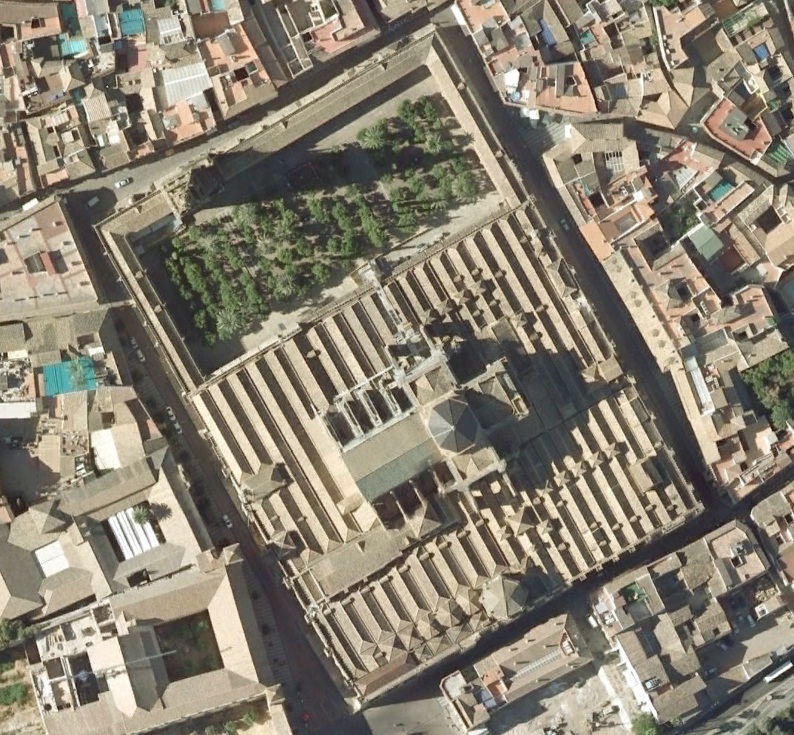
In this aerial view of the Mezquita, you can clearly see the cross-shaped cathedral jutting up out of the rectangular mosque. Fascinating.
I also read in the Wikipedia article that Muslims have been petitioning the Catholic Church for permission to pray in the Mezquita, but that the Vatican has refused. Just for the record, I think the Church should let the Muslims pray there. End of editorial.
Here's a picture of our first view of the Mezquita, from the southwest corner, where the taxi let us off:
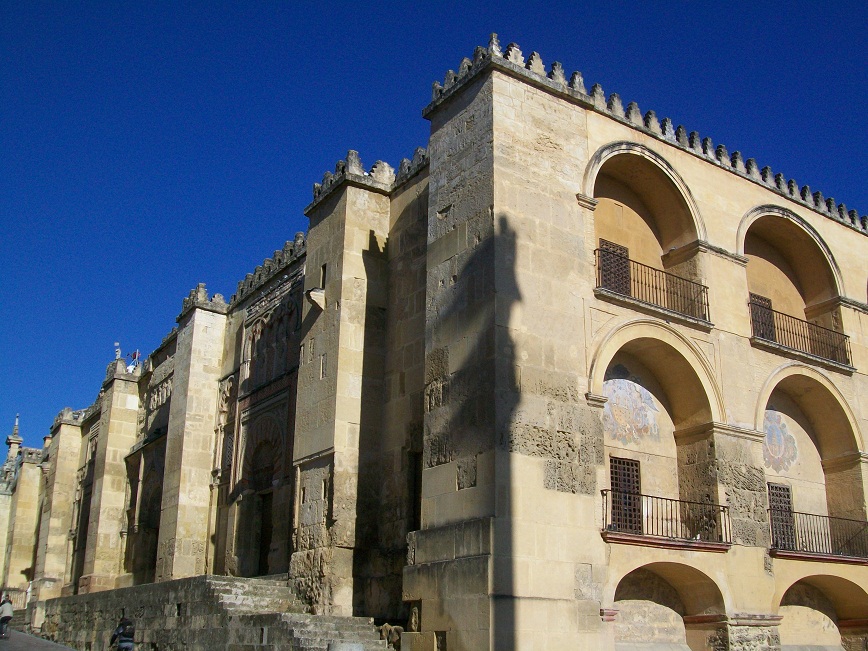
This is the main entrance. Notice the Christian paintings above the Moorish arch:

Here are two views of the former minaret, now a bell tower:

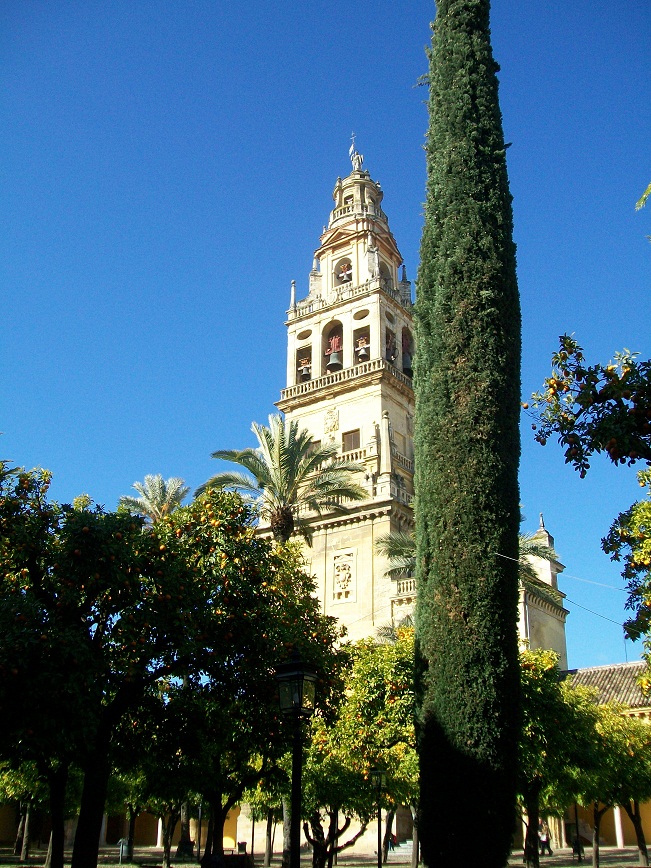
When you get inside, the first thing you notice is the forest of columns and arches:
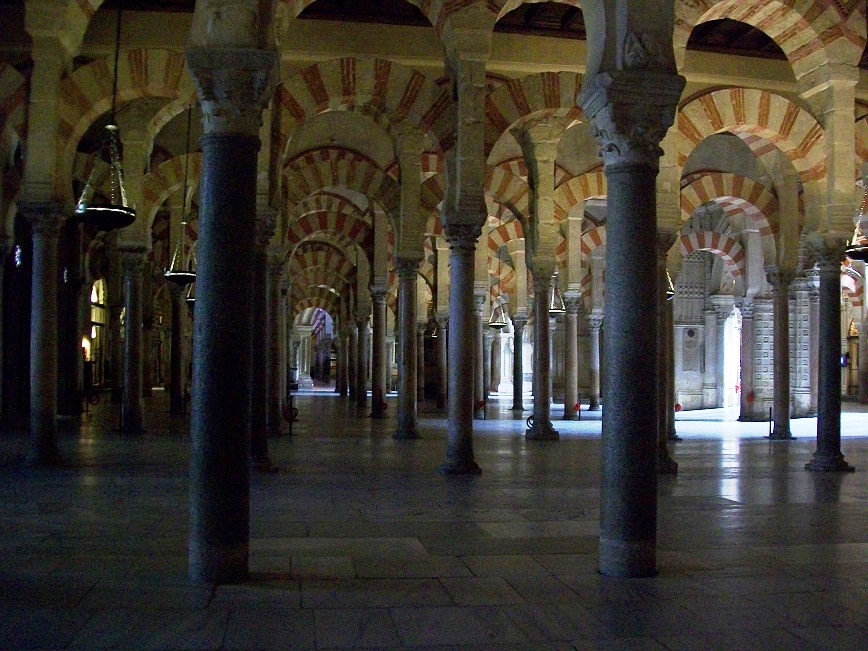
This was extremely impressive. I have to admit that it reminded me a scene from the first Lord Of The Rings movie, when they're in the Great Hall of Moria. I wonder if the scenic artists on the film were inspired by the Mezquita...
(Later, I did some Internet sleuthing on the subject. I didn't find anything that confirmed my suspicion about the film's artists, but I did find that several others besides myself made that connection.)
At one spot, there's an opening in the floor, where you can look down and see a portion of the tilework of the earlier Visigothic church:
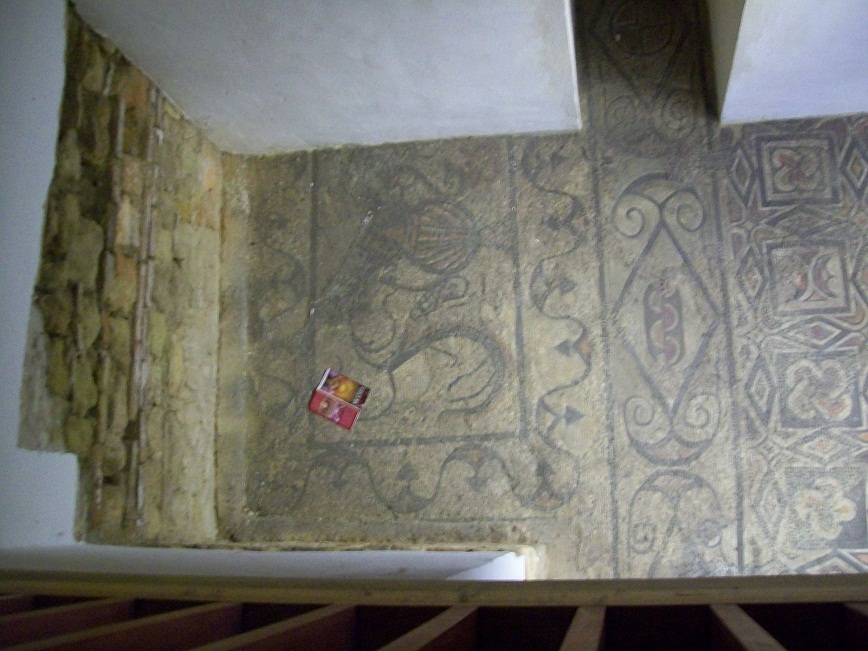
...as well as a tourist brochure that someone dropped.
On one side of the mosque is the mihrab, a niche in the wall indicating the direction of Mecca, that is, the direction that Muslims should face while praying. Here are three pictures of the mihrab, one looking directly into it, and the other two looking progressively upward:
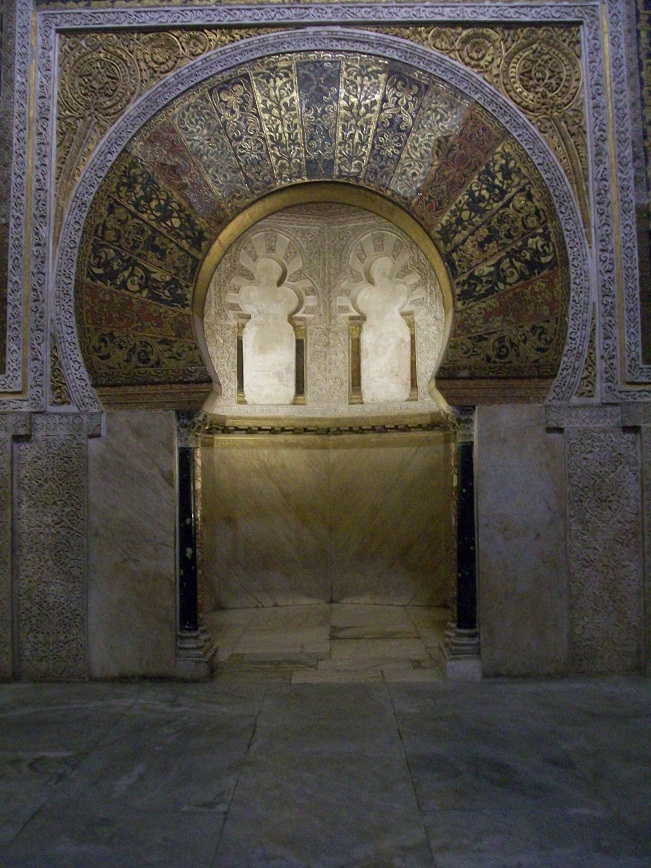
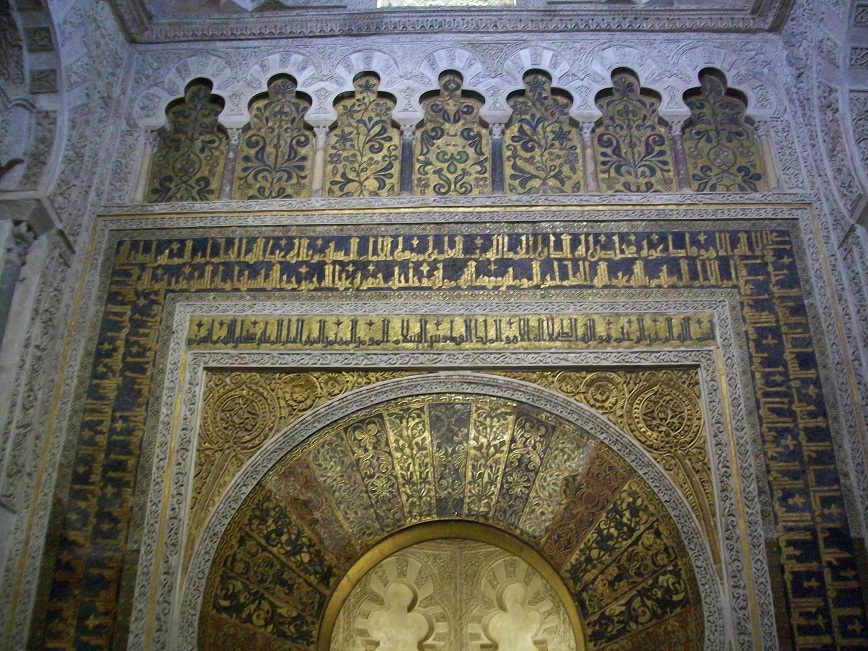
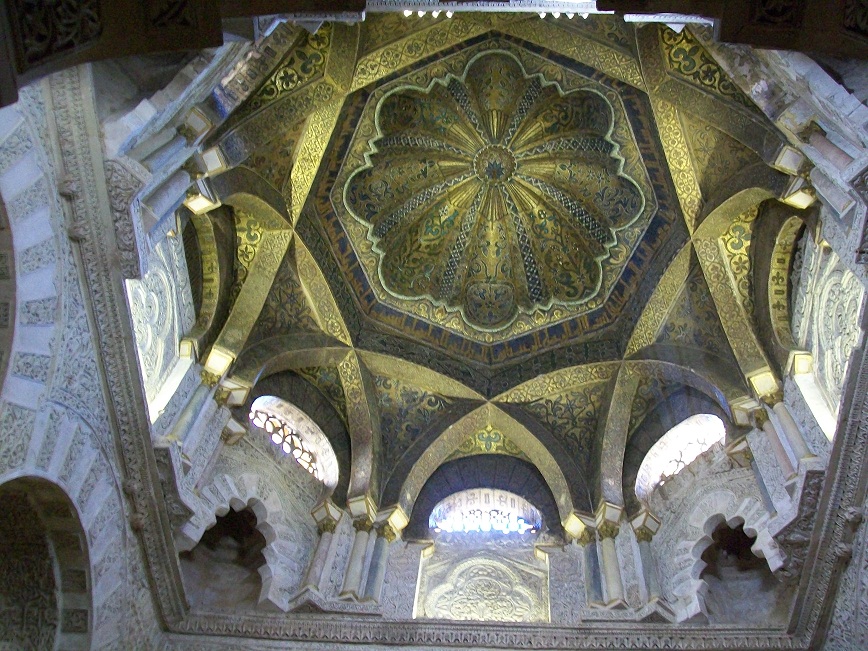
And then there's the cathedral inside the mosque. This picture of the pulpit, just to the right of the altar, gives an idea how the two were integrated:

The "choir" of a cathedral doesn't refer to singers, but a section of seats between the altar and the pews where the congregation sits. Sometimes these seats are occupied by high ranking church officials, sometimes by monks and/or nuns, and sometimes... by a choir. Anyway, in large, ornate cathedrals, the choir seats tend to display fancy, ornate carvings, and this cathedral is no exception:


In the first picture, the carvings represent scenes from Jesus' life. Those carvings are on panels above the actual seats. In the second picture, the carvings on the backs of the seats represent martyred saints, with the background of each carving depicting the place of their martyrdom. There must have been about 40 to 50 of these seats, and every one was different! Even the decorative woodwork between the pictures is different on each seat. Just imagine the time and effort that must have gone into the work. Amazing.
We then looked at the Treasury. Most big cathedrals have these; it's where the church's treasures are put on display. I was particularly taken by this statue of the Virgin - I like the expression on her face:
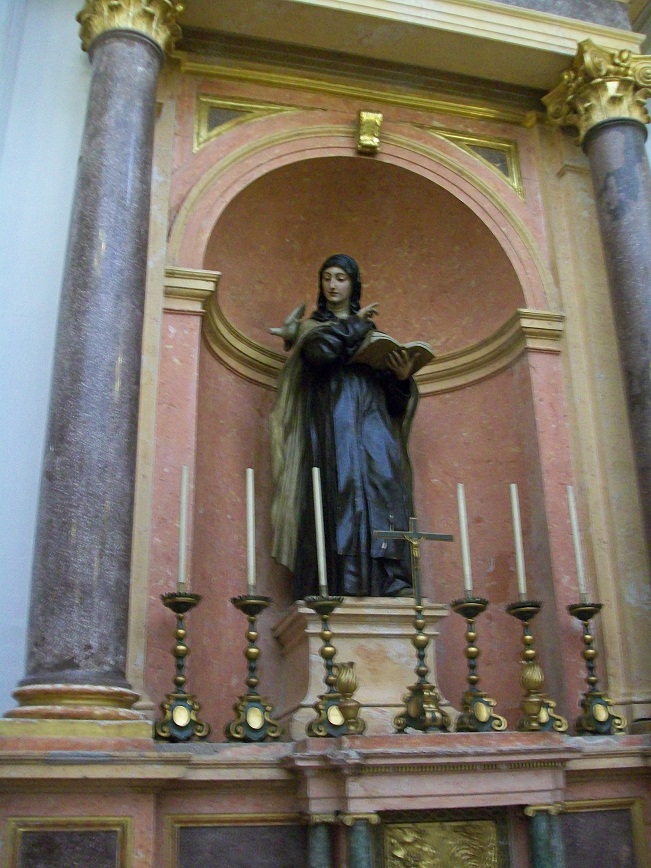
And then there was this ivory crucifix - again, the face is very expressive:

This painting depicts the Muslim rulers of Córdoba surrendering to the Christian conqueror. I was amused by the way he's shown standing tall and proud, while the Moors grovel at his feet, offering up the key to the city on a golden platter. Like they say, history is written by the winners:
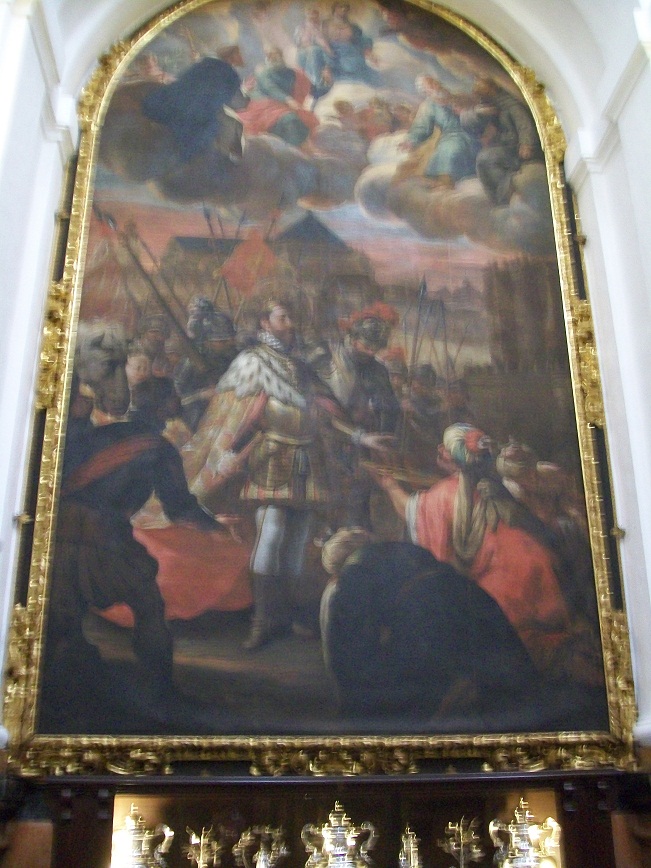
But the most amazing item was this monstrance. A monstrance is a receptacle to hold the host - the communion wafer. Now, to fully appreciate this, you need to understand the Catholic doctrine of transubstantiation. This means that the host, after being sanctified, actually transforms into the physical flesh of Jesus - while maintaining its outward appearance as a wafer.
Well, I'm not Catholic, and I don't believe in transubstantiation. To me, the communion bread is a symbolic representation of Christ's body, not the body itself. Still, I believe in being respectful of other people's beliefs. And I understand that, if you believe that the communion wafer becomes the actual flesh of Christ, it makes sense that you want to treat it with the utmost respect, and the vessel that holds the wafer should be something special, not just any old dish. I get that.
That being said, however, I really think this is a bit excessive:

Note the part in the red circle. That's where the host actually sits. The rest is all decoration. This thing is maybe about five feet tall, with amazingly intricate and detailed ornamentation, and it has six handles around the base so it can be carried. And of course, it's all solid gold. I was going to make some comment about the amount of money it must have cost, and how that money could have been used to feed the poor, but then I remembered Mark 14:1-9, and I decided I'd better not go there. (If you don't know what I'm talking about, look it up.)
The Mezquita sits on the banks of the Guadalquivir River, right by this Roman bridge:
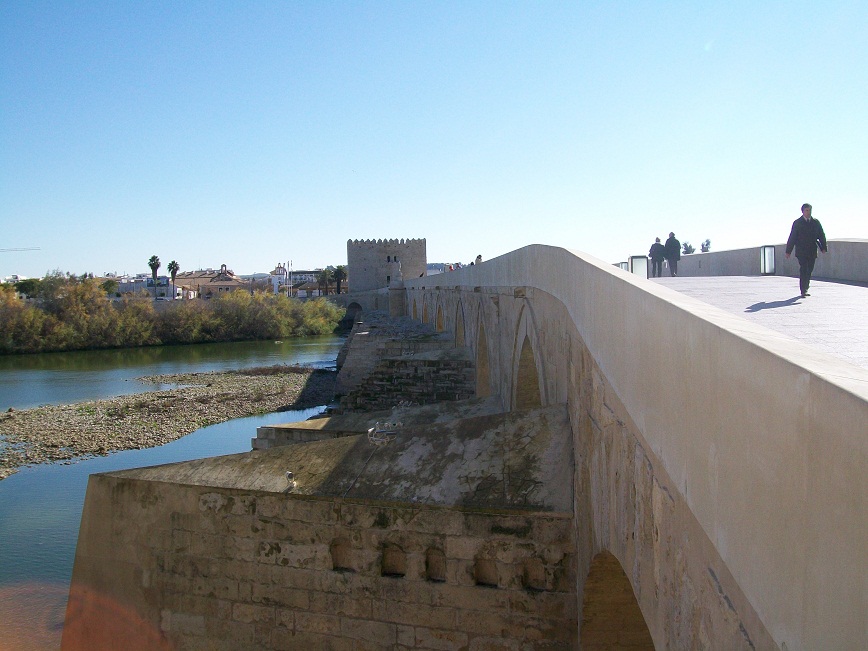
The building at the far side was originally one of the city gates, which now houses the Museum of Al-Andalus Life. According to our guidebook, this is "a velvety, philosophical, almost evangelical attempt to humanize the Muslim Moorish culture." It includes a video describing the history of the world's great religions, with particular emphasis on the virtues of the Muslim faith.
At first, we were interested. I have no problem with people of other faiths proclaiming how wonderful their faith is - after all, I feel the same way about my faith. But when we discovered that Roger Garaudy, the producer of the video and founder of the museum, is controversial for Holocaust revisionism... well, that place immediately got stricken from our agenda.
Behind the Mezquita, near the bridge, is this Triumphal Arch:
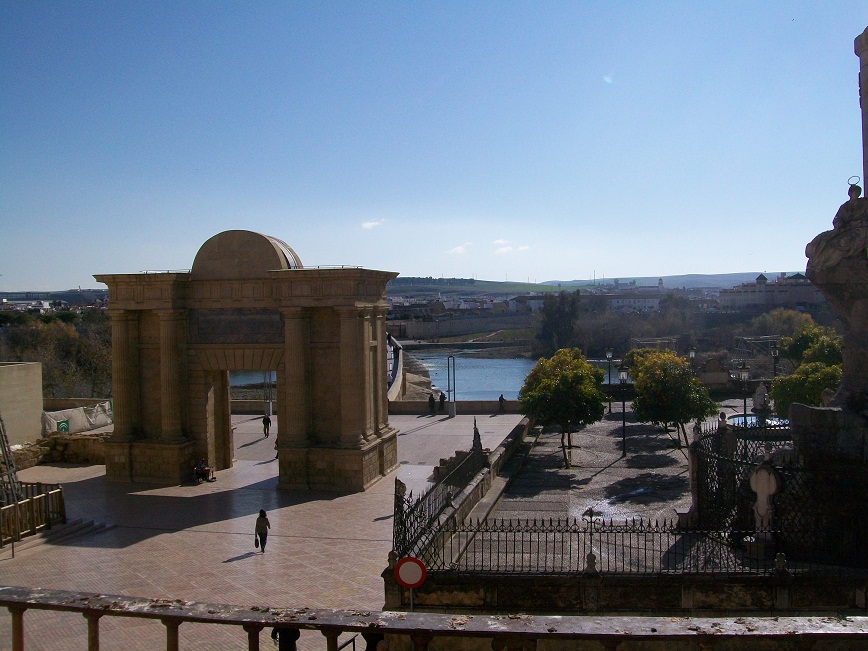

If you look closely at the first picture, you can see someone sitting at the base of the arch. When I walked through the arch, on my way to walk out onto the bridge (which was where I was standing when I took the second picture), I saw a man playing a cimbalom, a European instrument similar to, but larger than, a hammer dulcimer. He was busy tuning his instrument, but when I stopped to listen, he played a song, and I gave him a tip. He was selling CDs, but when I looked at the track list, I saw that more than half the songs were American pop tunes (one was "My Way"), so I didn't bother.

You may remember that we tried to visit the Arab baths in Valencia, but they were closed. Well, there were baths in Córdoba, too, and these were open. The baths are actually underground, and are mostly in ruins, but the site had interesting and informative displays and a video describing what they were like when they were in operation. In some rooms, they played a soundtrack of conversations that might have taken place in the baths. The conversations were in English - they must have thought we were tourists.
In a little park near the baths, I saw this monument:

It says, in Spanish and Arabic, "La Ciudad de Córdoba a los enamorados el poeta Ibn Zaydun y la princesa Valada 1971" (The city of Córdoba to the lovers, the poet Ibn Zaydun and the princess Valada). I had no idea what that referred to, but I was intrigued. I learned later that Ibn Zaydun (w) was a famous Arab poet who lived in Córdoba, and the princess Valada (or Wallada) was his lover - although apparently, she threw him over for someone else.
We then went to get some lunch, and had one of our only negative experiences with Terry's dog for the whole trip. Spain has laws, like the U.S., guaranteeing guide dog users access to public places, including restaurants. In every restaurant we went into, we had no trouble about the dog... except this one. The waiter took us to a back room, where we were all by ourselves, because he was afraid that other customers would object to the dog. Terry took exception to this, of course, and after some angry words back and forth, the man suggested that we could always go somewhere else - so we did.
Spain has a large Roma (gypsy) population, and while of course most of them are perfectly honest, the guidebook did warn us about beggars and pickpockets. While we were walking to the restaurant, we saw a woman who I believe was Roma, carrying a baby, and begging for spare change. She looked rather pitiful... until I saw another woman, dressed the same way, also carrying a baby. And a few minutes later, I saw another one. I mentioned to Terry, "I'm beginning to sense a pattern here."
Most Spanish cities had a Jewish quarter, and we walked through some of them, but in most cases, there's nothing today that looks particularly Jewish. Córdoba, however, has an old synagogue, which was the next place we went, after lunch. It's just a single square room, but it has ornate carvings on the walls, including Hebrew inscriptions which are all taken from the Psalms. It was empty when we got there, but while we were reading interpretive signs translating the Hebrew into Spanish and English, a guided tour group came trooping in:

...which sort of broke the mood. But I did get a picture of the synagogue's menorah:
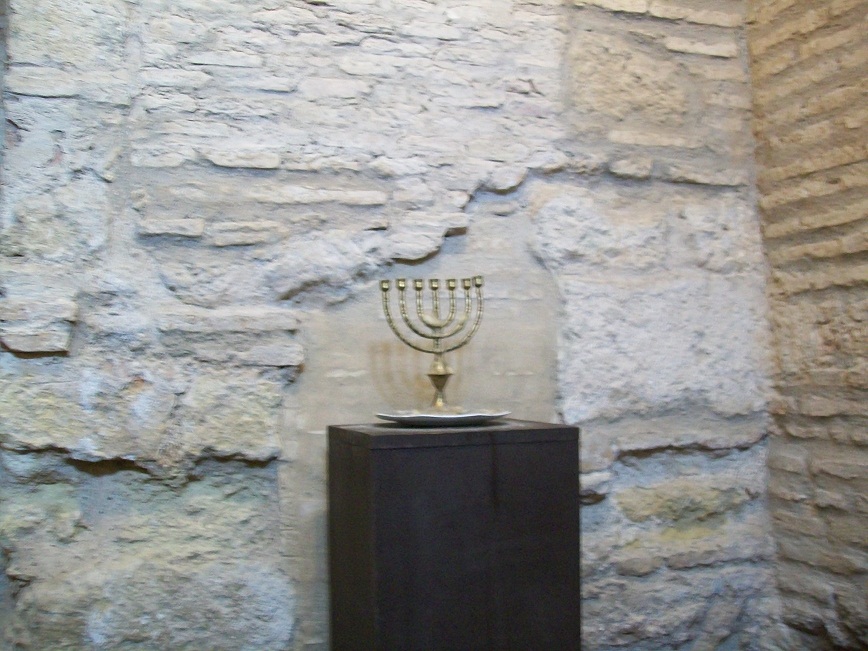
Another place we read about in the guidebook, and were interested in seeing, was the Casa de Sefarad, a museum dedicated to Spanish Judaism. Unfortunately, it was closed, because the guy who runs it was on holiday. But I did get this picture of a statue of the famous Jewish scholar Mainmonides (w), who lived in Córdoba in the 12th century:

A large section of Córdoba's old city wall is still standing, and I took some pictures:

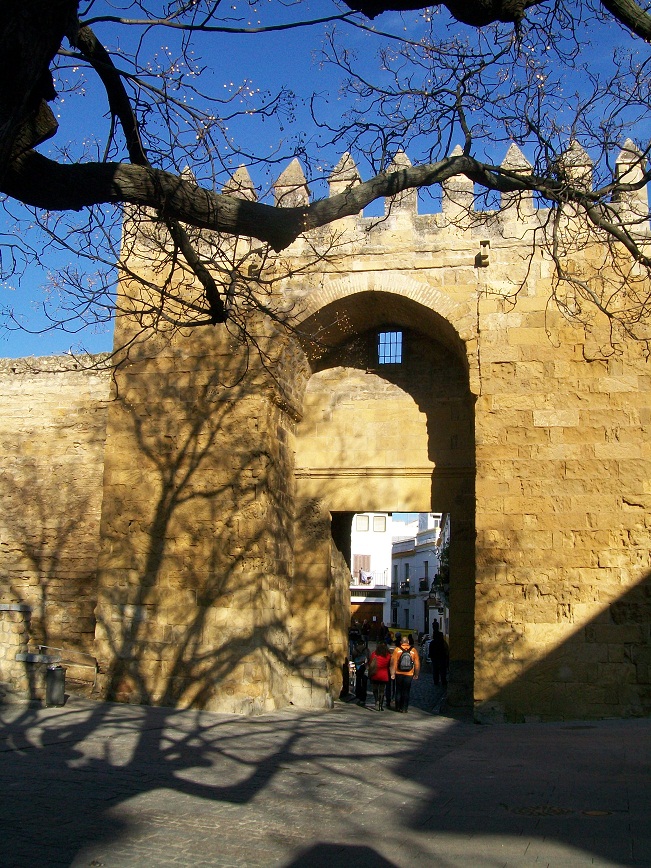
And somewhere during the day, but I don't remember exactly where, I took this picture, just because I was amused by the contrast between the large old lock and the much smaller modern lock:

We took a cab back to the train station, and discovered that we had just missed a train, and the next one wasn't for an hour and 45 minutes. So we had some coffee and dessert at the station while we waited. And we eventually got back to the resort, got some dinner, and went to bed.